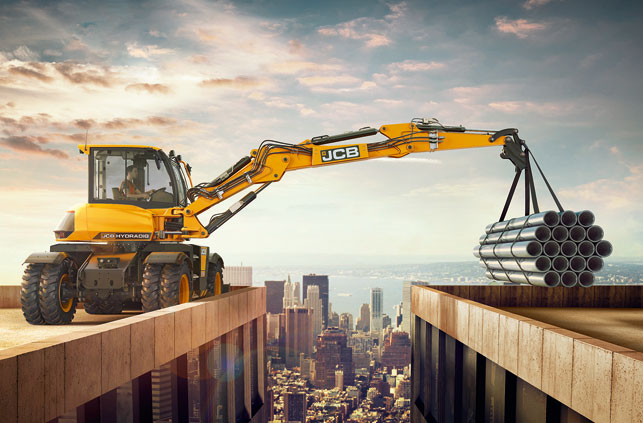Today JCB is an acronym synonymous with British manufacturing. However, it comes from very humble beginnings. Joseph Cyril Bamford founded the company in a 12 ft by 15ft garage in 1945 in which he built agricultural tipping trailers. Seventy years later, and not far from that original ‘factory’ in Uttoxeter, Staffordshire, JCB is now a global manufacturer with 350 different products, 12,000 employees and 22 plants, 11 of which are in the UK.

With a lower centre of gravity, the allnew JCB Hydradig is extremely stable and offers a lift capacity of 1,000kg
“Since JCB began in 1945, we have always been driven by innovation and that is at the very core of ‘The Story of JCB’. It is a unique story of constant investment in our 22 plants on five continents, to become one of the world’s largest manufacturing companies,” says Mr JCB’s son, Anthony Bamford (now Lord Bamford), who took over the reins from his father in 1975.
Having brought many innovations to market over the years, in 2013 the company decided it needed a dedicated Innovation Centre, a top secret lair in the belly of its headquarters to house its designers and engineers and all the cutting edge tools, technologies and space they’d need to explore, share, prototype and test new innovations.
And one of these innovations, which was created under lock and key in the Centre is the all-new JCB Hydradig, although during its three year development period it was codenamed ‘Project 710’.
“We set up the Innovation Centre three years ago and really needed a project that would allow for creative thinking to flourish so the timing was perfect to bring them both together,” says Tim Burnhope, JCB’s chief innovation and growth officer.

JCB is still a family owned company with Lord Bamford as its chairman. Here he is standing besides the all-new Hydradig at its launch earlier this year
Revolutionary innovation
A large proportion of JCB’s innovation effort is focussed on evolutionary design and the enhancement of existing products. “We launch between 55 to 65 new models every year and so to stay ahead our product development to create incremental improvements to our products is absolutely relentless. However, every now and then, we’ll work on a revolutionary innovation,” comments Burnhope.
“Lord Bamford initiated ‘Project 710’ for a wheeled tentonne multi-tool carrying solution and that was based on feedback from a number of our customers and dealers in not only how industry was changing but more importantly how the methods of our customers were changing.”
To JCB nothing is more important than its customers. Right from the very early days, one of Joseph Cyril Bamford’s mottos was that ‘our customers can get along without us, we can’t get along without them.’ So Project 710 kick-started with customer research to really uncover what they wanted from such a machine. A team was assembled to analyse how users in various fields – including utilities, highways, municipalities, general construction and landscaping – were using current machinery solutions.
“We are very good at doing what we call application studies, which is very exciting. Well, exciting for us at least,” smiles Burnhope.
“We will observe and video how jobs are done and what equipment and attachments are being used. Sometimes things aren’t done in the most efficient way and so we can then review and work out how we can improve on it.”
Customer challenges
From this work five key customer challenges were uncovered. Top of the list was visibility. With the engine in its current position at the top of the machine, operators could only see to the horizon and were quite blind to the area below. “Especially in city areas which are really tight, they want to be able to see pedestrians going past or a workmate standing in a trench,” comments Burnhope.
The second challenge was on stability, especially as machines are being used not just for excavating but for heavy lifting too. For machines to be able to lift 500kg, a large counterweight would be needed to keep all wheels on the ground. The problem with counterweights, as Burnhope explains, is that when the machine swings round, the rear end can hit walls or obstructions.
JCB’s ambitions for the Hydradig were even higher though. The company tasked its designers to develop a machine which could lift 1,000kg – and with a vastly reduced counterweight. This would ensure virtually no overhang over the wheels, almost eradicating those collisions with walls.
The next three challenges included manoeuvrability – especially in congested urban environments, mobility – quicker machines to move between areas, and serviceability – easy access to service the machine and preferably from ground level.
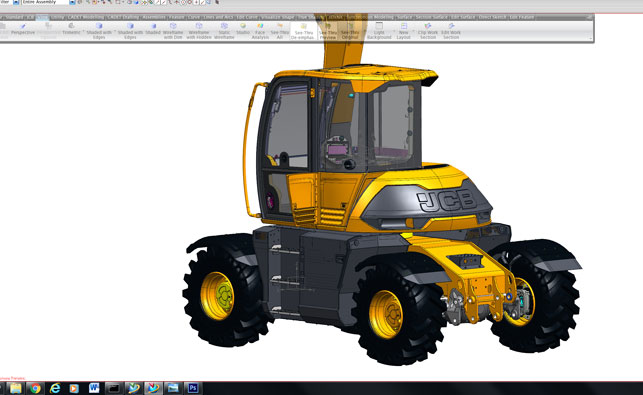
The Hydradig taking shape in Siemens NX
Single solution
It would be no mean feat to deliver a single solution that could meet all these customer requirements. So, JCB set to work by setting up a project team pulling on employees from across the business. Concepts were explored through brainstorming sessions and sketching.
In terms of the first challenge of visibility, the team used a pyramid shape as the inspiration for perfect visibility. This then sparked the question: what if the engine was located, not behind the operator obstructing the view, but in the lower chassis?
Through constant sketching, ideas were being explored but, as Burnhope remarks, in this early stage most of the individual customer requirements conflicted with one another. “We wanted a machine that could lift twice the load but for it to do that we’d traditionally have to put more counter weight on the top to make it bigger but then that would affect visibility.
“We had a few different teams working on the various areas of the product and all sketches were pinned on the wall so we could see how different themes were emerging.”
The industrial designers started to model some of these ideas in Alias and the machine began to take shape. Although JCB’s products are very functional work tools, styling is still incredibly important. “First impressions are crucial but it’s more than that,” says Burnhope.
“When it comes to the JCB’s design methodology we use the term ‘strength with purpose’. So, with this machine, we put a lot of emphasis on making sure the visibility works but also ensuring that it’s got great shape and looks strong.”
Team work
The beauty of the Innovation Centre is that it’s very conducive to team work as an area is specifically dedicated to hot desks. This meant that the industrial designers working in Alias could work side by side with the engineers working in Siemens NX. This helped to ensure the design intent was kept even if engineering changes meant a tweak to the shape.
In fact, there was a great deal of detailed calculation that had to be carried out by the engineers in the early stages with the requirement to reposition the engine in the lower chassis. “As well as improving visibility, we realised we had to lower the whole centre of gravity to be able to offer a lift capacity of 1,000kg whilst having the shortest tail swing in the industry. Rather than it acting like a counter weighted machine, we wanted to feel like we were strapped down to the ground.
“That took us about six weeks to crack with different calculations, movements, design and shape of counterweight,” says Burnhope.
During this process the team also made extensive use of the 12 x 2.5 metre powerwall. Here engineers and designers can view, rotate and manipulate 3D CAD drawings from multiple perspectives at almost 1:1 scale. They can zoom in to within millimetres of the drivetrain layout, for instance, to help them decide whether they have the right ground clearance or engine depth.
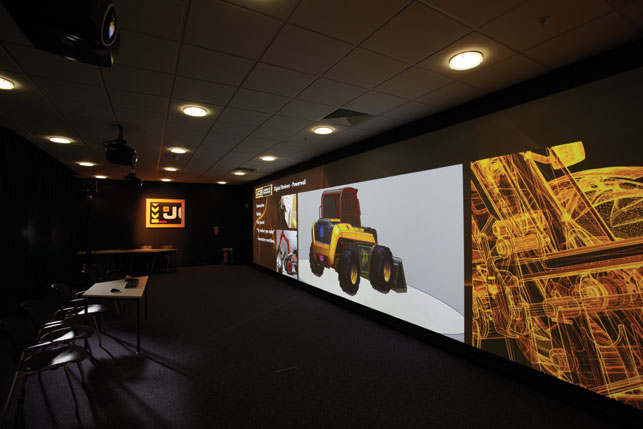
The powerwall is used a great deal during the development process by the design team but also for design reviews with colleagues in other departments
“The powerwall is fabulous because we can get that level of detail before we even start to do a prototype. With the power of computing, we can look through the machine to inside the chassis, which you wouldn’t be able to do with a classic prototype. It’s a huge advantage in the product development process,” says Burnhope.
In the case of this machine the powerwall particularly helped the engineering team come up with innovative ways to pass the services through the slew ring, a rotational rolling-element bearing that supports a heavy load.
“In a typical prototype machine you wouldn’t see the slew ring because it is hidden but the beauty of the powerwall is we can look at all those designs by stripping away the top of the machine so we can really start to understand how we supply these services through in a different but very practical way,” he comments.
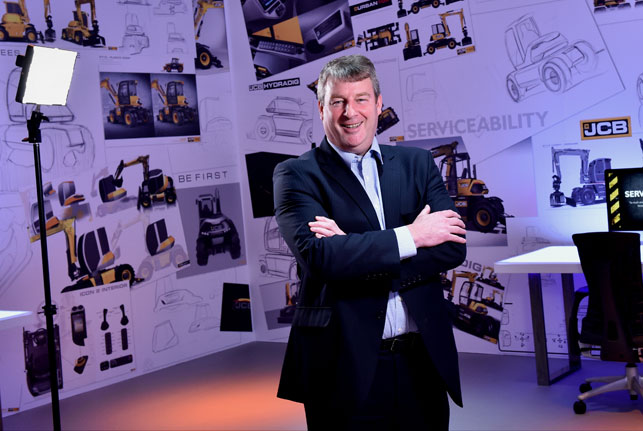
Tim Burnhope, JCB’s chief innovation and growth officer, standing in front of various Hydradig concept sketches
Sharing the vision
As well as design reviews, the powerwall is also used to communicate the design vision to colleagues in other departments, including the manufacturing teams who can provide input into how the machine will be built and assembled in the factory.
Once everyone is happy with the CAD model, a tenth scale prototype is produced in the Rapid Factory within the Innovation Centre. This helps to validate the industrial designs and by holding it in their hands, the team can really scrutinise the angle of the operator’s eyeline to establish whether they can see all the way round the machine and if there are any blind spots they weren’t aware of before.
During this whole development process Lord Bamford is also very much involved with weekly and, at certain points in the project, even daily meetings. He’d view the designs on the powerwall or the team would take prototypes up to his office. “He’s been running the company since 1975 so he’s worked on many innovations over the years and knows how tough it can be at times. It’s fantastic to have a confident, inspirational leader who says, I know it’s going to take a little while but I want you to go away and crack it,” says Burnhope.
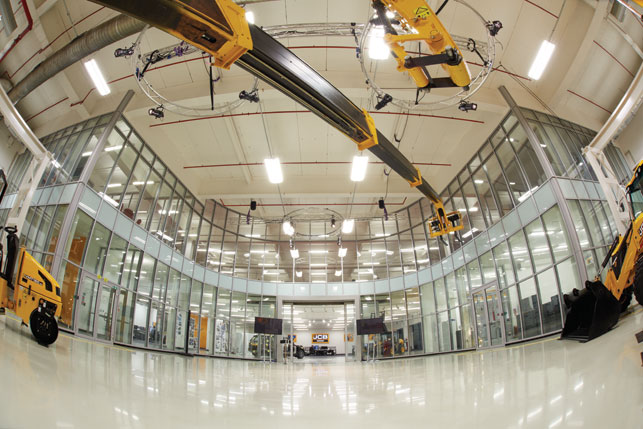
The top secret Innovation Centre at JCB HQ, which was set up in 2013
Ready for launch
Following almost three years in development JCB’s top secret Project 710 had become the all-new Hydradig – a completely new machine type that could do three times what its predecessor could in a completely different configuration.
All five key customer challenges had been met and, although Burnhope and his team had confidence in what they deem to be a revolutionary innovation that will reinvent the industry, the real test would come at its debut, which took place earlier this year at Bauma, an equipment trade fair in Munich.
“It was quite nerve wracking but we were actually blown away by all the positivity. We’ve had some fantastic articles from the trade press and for me that’s great because our engineers don’t often see or hear enough about the designs. We also had quite a few compliments from our competition and it was nice to have that pat on the back too,” he says.
With orders coming in, full production of the Hydradig at the JCB Heavy Products factory in Uttoxeter has begun in earnest.
The story of JCB
No visit to JCB HQ is complete without a factory tour and a look around the visitor centre. The latter is a £5 million exhibition space opened in 2011 that showcases the ‘Story of JCB’ from the Bamford family’s industrial roots in the 1820s, through Joseph Cyril Bamford’s first handmade machine in the 1940s, to the 2006 record-breaking Dieselmax car and a hugely impressive JCB JS200 tracked excavator built to scale out of 8mm steel rod created by artist Benedict Radcliffe.

The assembly line of the Backhoe Loader
There is also a glass cabinet dedicated to JCB’s 30 Queen’s Awards and a circular ‘vault’ in the floor that is home to some of the almost 1,000 patents held by JCB.
There is also Mr Bamford’s old office, which he used from 1970 until his retirement in 1975, and still contains his original desk, chairs and conference table as well as a bronze bust of himself on his desk, which was a gift from the workforce in 1964 when he presented in excess of £250,000 in productivity bonuses to his staff.
A short walk from the centre, the Story of JCB continues with a tour of the Backhoe Loader factory where thousands of machines are made every year. Walking alongside the assembly line the machine literally comes to life from the delivery of the sheet steel, profiling, laser cutting, welding, paint shop, assembly and finished product.
Both the above are worth a visit, not least of all to see what it takes to produce one of these machines. Those who are interested can find details of booking a tour on JCB’s website.
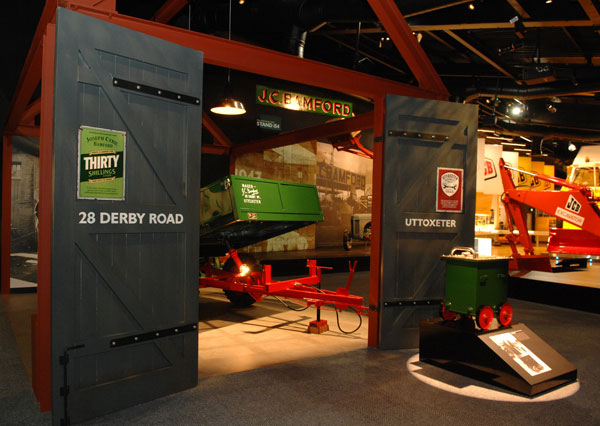
Where the Story of JCB first began — in the garage of Mr JCB

The development of JCB’s revolutionary Hydradig
Default

